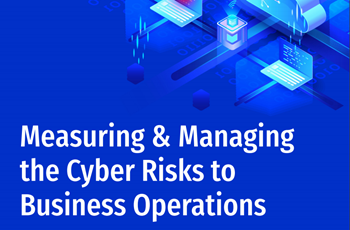If the global pandemic problem taught us anything, it’s that bad actors are keen to exploit flaws. Since the outbreak's inception, the FBI has received up to 4,000 new cybersecurity complaints each day, a 400% increase over previous levels. The financial and healthcare sectors are critical targets.
Banking is 300 times more vulnerable to cybersecurity breaches, with annual losses topping $18.3 million per business. Simultaneously, healthcare has the highest cost per compromised data record of any business, mainly owing to important insurance data.
Remote working has also created additional concerns since it allows dispersed teams access to the company's network and cloud-based server solutions, often via personal devices. Smart devices can also be used to gain access to the home network and, once compromised, to leverage commercial operations.
Many businesses in the post-pandemic economy continue also to operate remotely today, and this trend is expected to continue in the new normal. Eventually, hybrid working will become the norm, and with this hackers will continue to target system flaws and exploit human mistakes – regardless of where your staff work from.
So how can you effectively address the vulnerabilities of hybrid work?
1. Scan and quarantine
Consider any gadgets used away from home to be high-risk. Then, before connecting the devices to your trusted workplace network, go through the following steps:
- Separate the devices from your workplace network by quarantining them. Consider getting a separate internet connection to separate your essential business traffic from the rest of the internet.
- Scan the devices and patch any vulnerabilities to prevent them from spreading.
- Ensure that antivirus software is up to date and the most recent updates for the operating system and all other software and apps.
- Check that the security protections you installed previously (for example, strong passwords or multi-factor authentication) are still in place.
2. Secure cloud data
Whatever solutions are deployed, they must be cloud-centric. In the last year, 76% of businesses embraced cloud services quicker than expected. According to Check Point and Cybersecurity Insiders’ 2020 Cloud Security Report, 82% of companies believe traditional security solutions either don’t operate at all or have limited functionality in cloud settings (a significant drop from the previous year's survey result of 66%).
The best strategy to maintain cloud-based network security in a hybrid work environment is to adopt zero trust architecture, which NIST defines as an approach that assumes no implicit trust is provided to assets or user accounts based simply on physical or network location.
Before getting network access, each entity must authenticate its identity and trustworthiness under zero trust. Micro-segmentation, an essential component of a zero trust policy, can be accomplished by utilizing software-defined networking services and cloud solutions. This type of stringent network traffic control aids in maintaining a strong security posture across the network.
3. Maintain secure systems
The majority of cyber-attacks are directed at companies with obsolete computers and systems that haven’t had essential security updates or patches updated in a long time. Hackers can rapidly get access to company networks and systems if security is lax. They may also employ ransomware to extort money to regain control of systems and databases.
The first line of protection against cyberattacks is to keep systems up to date, especially while working remotely. Ensure that you have a dependable IT team and procedures in place to safeguard your devices and networks from viruses and hackers.
Antivirus software is a cybersecurity cornerstone that provides security capabilities such as firewalls, spam filters, real-time scanning and security reports, among others, to guard against various viruses.
4. Safeguard your network
A robust network security infrastructure is also essential. Employees can now access company data and cloud services from a variety of endpoints, devices and locations. The network's security will be a top priority amid such scattered activity.
Fortunately, there are several alternatives for strengthening an organization's network security posture. Endpoint detection and response (EDR) collects and aggregates data about endpoint use and analyzes it for risks, sometimes with AI/ML. EDR, as part of a defense-in-depth strategy to security, monitors and analyzes not just a network but all endpoints communicating inside that network.
It provides digital forensics to detect areas of vulnerability when deployed directly on the network as an internal platform. A good EDR solution is intended to achieve three major tasks:
- To identify risks, monitor, and gather data in real-time
- Analyze the data obtained to identify threat trends
- Respond to any identified threats quickly, isolate the affected endpoint, and then eliminate the threat
5. Enforce a robust cybersecurity plan
A practical, company-wide cybersecurity policy may assist companies in outlining the best practices for their workers to follow when hybrid working and ensuring they take the required precautions to safeguard corporate information.
A robust cybersecurity strategy is critical for pushing the word from the top and boosting staff knowledge. Check that the cybersecurity policy includes the following provisions:
- The importance of cybersecurity
- Recognizing cyber threats such as phishing and ransomware
- Installing security updates and patches
- Keeping computers and devices secure when not in use
- Effective password management
- Using email and the Internet securely
Develop a cybersecurity plan for hybrid work
Not many organizations will return to an entirely in-office setup. Some people may contemplate making a permanent transition to working from home. On the other hand, others may prefer a hybrid strategy, with the ability to alternate between working in the office and working remotely.
Create a cybersecurity plan for this hybrid working arrangement
- To start, conduct a risk assessment for this scenario
- Look into what worked for you in the past when employees were in the office and what worked for you while they were working remotely
- Plan to combine them all for a more flexible way of working
Adjust your plan as you go, conduct frequent risk assessments and do regular monitoring to ensure that your cybersecurity plan fits your needs and work setup.
6. Train your team on cybersecurity best practices
Your employees' cybersecurity expertise may be rusty when they return to work, which is understandable.
Re-educate them on your cybersecurity policies and be proactive. It can take security awareness training, so they’re aware of the old and new dangers to be wary of and the processes to follow and measures to take. It assists employees in remaining vigilant and re-establishing vital cybersecurity behaviors.
Many experts consider cybersecurity awareness training to be a vital issue in today's hybrid workplace. Many hacks are sometimes ascribed to workers accidentally establishing an access point into systems that hackers may exploit.
It all boils down to a lack of understanding, which can put your staff in danger of making mistakes in judgment, resulting in information security breaches, downtime for your organization or financial loss.
Ample employee education lowers the chance of successful cyber and social engineering assaults. Ascertain that your awareness training program can deliver effective learning interventions over a long period.
After all, learner engagement and information retention are critical components of practical awareness training and return on investment.
7. Update your cybersecurity plan
As your workers return to offices, now is the time to update and record your cybersecurity plan. Consider adding extra security, employing sophisticated technologies or implementing a more comprehensive solution.
There’s no question that cybersecurity should be everybody’s business. Constantly update cybersecurity plans, especially as new threats come along. In the new normal where almost every operation is performed online, protection, cybersecurity and awareness is crucial for businesses to keep thriving in a highly digital business era.
Conclusion
Yes, there are vulnerabilities to hybrid working, but these vulnerabilities don’t outweigh the benefits that remote working and hybrid working bring to the table.
It’s provided a way for continuity, for individuals and businesses to bounce back and recover from the devastating effects of the pandemic still raging worldwide. Aside from the pandemic, other threats and difficulties challenge the modern-day worker. Striking a work-life balance is among those challenges, especially felt by working parents.
Other challenges include logistics--like traffic or the physical distance of workers’ homes from their workplace (as city housing continues to rise). Hybrid working provides the incentive of living anywhere without being deprived of viable sources of income. Safety is also a consideration. With a more global economy, your usual 9-5 working hours are no longer the standard. Remote or hybrid workers now can take on jobs at odd hours and accept offers from varying time zones while in the comfort and safety of their homes.
Emerging digital innovations continue to keep up in answering the problems and challenges of the modern-day workforce so they can work from home efficiently. Businesses or companies need to step up their game in ensuring their business, their employees and their consumers are getting the best cybersecurity they can afford.
Access the latest business knowledge in IT
Get Access


Comments
Join the conversation...